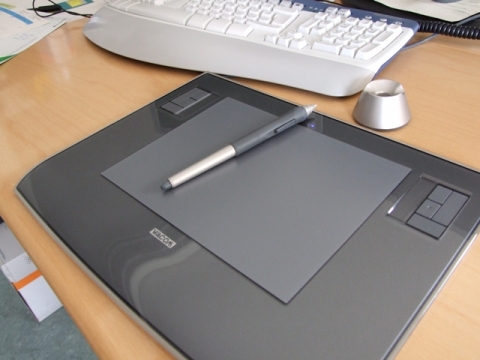This is the final solution for my Repetitive Strain Injury (RSI).
It replaces my computer mouse completely. On the tablet, a pen is used instead a mouse. So when moving the pen - the cursor moves. Holding this pen is much more natural than operating a PC mouse.

Also read my complete repetitive strain injury medical history compendium and my solution abstract.
Bought it on Amazon:
Repetitive Strain Injury Solution Update 🔗
The year 2024 is here, and it’s time to revisit the information provided in 2011 regarding the Repetitive Strain Injury (RSI) solution using a Wacom Intuos Graphic Tablet. At that time, the author emphasized that the tablet replaced the computer mouse completely, with a pen being used instead to operate the cursor. This solution was praised for being more natural and potentially beneficial for individuals experiencing hand and wrist pain, as well as Carpal Tunnel Syndrome (CTS).
As we look at the current years 2021 to 2024, it is evident that technology has continued to advance, leading to new developments in addressing RSI and related conditions. While the concept of using a graphic tablet as a mouse alternative may still be relevant for some individuals, there are additional options and considerations to explore in the present day.
One notable update is the introduction of ergonomic mice specifically designed to reduce strain on the hand and wrist. These mice often feature a more comfortable grip and customizable settings to accommodate different users’ needs. Furthermore, voice-activated commands and gesture control technologies have gained popularity, providing alternative ways to interact with computers without relying solely on traditional input devices.
In the realm of graphic tablets, manufacturers have released updated models with enhanced features such as pressure sensitivity, tilt recognition, and wireless connectivity. These improvements aim to provide a more intuitive and seamless drawing experience for digital artists and professionals working in design-related fields.
Moreover, the awareness of RSI and ergonomic practices in the workplace has grown significantly over the years. Employers are increasingly implementing ergonomic assessments and adjustments to create healthier work environments for their employees. This holistic approach includes ergonomic furniture, proper workstation setup, and regular breaks to prevent prolonged periods of repetitive tasks.
As we reflect on the initial solution proposed in 2011, it is important to acknowledge that while the Wacom Intuos Graphic Tablet remains a viable option for some individuals, the landscape of RSI management and prevention has evolved. It is recommended for individuals experiencing RSI symptoms to consult with healthcare professionals, ergonomic specialists, or occupational therapists to receive personalized recommendations tailored to their specific needs and circumstances.
In conclusion, the year 2024 brings with it a wealth of new technologies and practices aimed at addressing RSI and promoting overall well-being in the digital age. By staying informed and proactive about ergonomic principles and technological advancements, individuals can strive to maintain healthy computing habits and minimize the risk of repetitive strain injuries in the years to come.